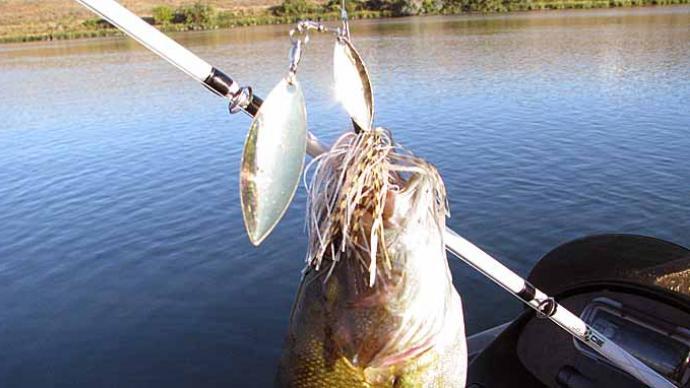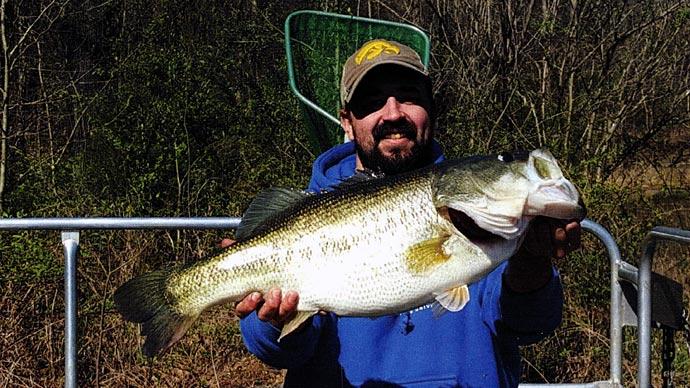
The first time I saw a spinnerbait, I wouldn’t have given a nickel for it. That was many years ago – more than I care to admit. Since then, however, the lure has put many nickels in my pocket.
The first one I fished was a Zorro Aggravator – a terrible-looking thing that amazed me every time I used it. But man, did it catch fish! All I had to do was throw it out and wind it in.
Much has changed since then, especially now and where I use spinnerbaits. Frankly, if I were using them today like I did then, I wouldn’t catch many fish. Bass seem to be educated on spinnerbaits, but fortunately, so am I. This lure is far more sophisticated than most people realize.
If you catch fish on a worm or crankbait, people want to know what size, color, style, and type of retrieve you used. Catch them on a spinnerbait, however, and they ask only, “What color?”
There are as many significant differences in spinnerbaits as with crankbaits and plastic worms. Like everyone, I have preferences, but I’ve learned the importance of experimenting to produce the best results.
When I won a Bassmaster Missouri Invitational on Truman Lake in 1988, I tested several variables during practice. I changed not only the color of the spinnerbait but the size and blade as well.
During the tournament, my partners and I fished shoulder-to-shoulder, throwing spinnerbaits around logs, stumps, and brush, yet I caught more and bigger fish from the same brush piles. My presentation wasn’t better than theirs, but my lure was what the fish wanted. The 3/4–ounce spinnerbait with the No. 3 Colorado and No. 7 Indiana blades was the proper weight and vibration.
I prefer a tandem spinnerbait 90 percent of the time because it snags less often, offers more flash than a single spin, and the two-bladed design keeps the lure upright when it bangs limbs and logs. The added vibration is essential in most situations. To maximize the effect, I never use the same size or style of blades on one lure.
I want the blades to turn at different speeds to increase vibration, something I can feel as the lure moves through the water. If the lure isn’t vibrating well, I’ll slow it down, speed it up, or jerk the rod until I can feel it working or “chiming” again.
The ¾-ounce size has been my favorite for a long time, especially when matched with the right blades and a strong 32-gauge wire. Fish prefer the water displacement and vibration this lure size produces.
I’ll use a ¼-ounce spinnerbait in cold water when fish seem less aggressive or when the water is calm. In a situation with no wind on a shallow bay filled with scattered grass and lily pads, I’ll run the ¼-ounce spinner slightly beneath the surface. It’s also a good lure for flipping into heavy brush.
As a compromise, I’ll choose a 3/8-or ½-ounce model. This size lets me switch to a larger blade for more vibration; big blades make smaller baits roll when retrieved quickly.
Although lure weight and blade size are more critical, spinnerbait color should also be considered. Keep in mind that preferred colors can vary from lake to lake. In general, I like chartreuse and white in dingy water on a sunny day, chartreuse in dingy water on a cloudy day, white in clear water on a bright day, and blue and chartreuse in clear water on a cloudy day. I carry every blade color imaginable, but prefer shiny, gold-plated versions. I also prefer thicker blades because they rotate better and seem to vibrate more.
What else do I want in a spinnerbait? A big 5/0 hook, a No. 40 flat-rubber skirt, and a plastic trailer. I seldom choose living-rubber skirts and avoid trailer hooks unless fishing open water or rocks. When throwing a spinnerbait in the middle of a brush pile, I’d rather not worry about the trailer hook snagging.
The plastic trailer is essential. I prefer the round-bodied, flat-tailed versions. They work better as a keel on big spinnerbaits, keeping them upright with a fast retrieve. When fishing a big bait that needs more buoyancy, I’ll opt for a larger soft-plastic trailer.
There are days when any spinnerbait will work. By experimenting, however, you may discover a more effective way to catch more and bigger fish.
You can find more articles, quick tips, and more at HankParker.com.




